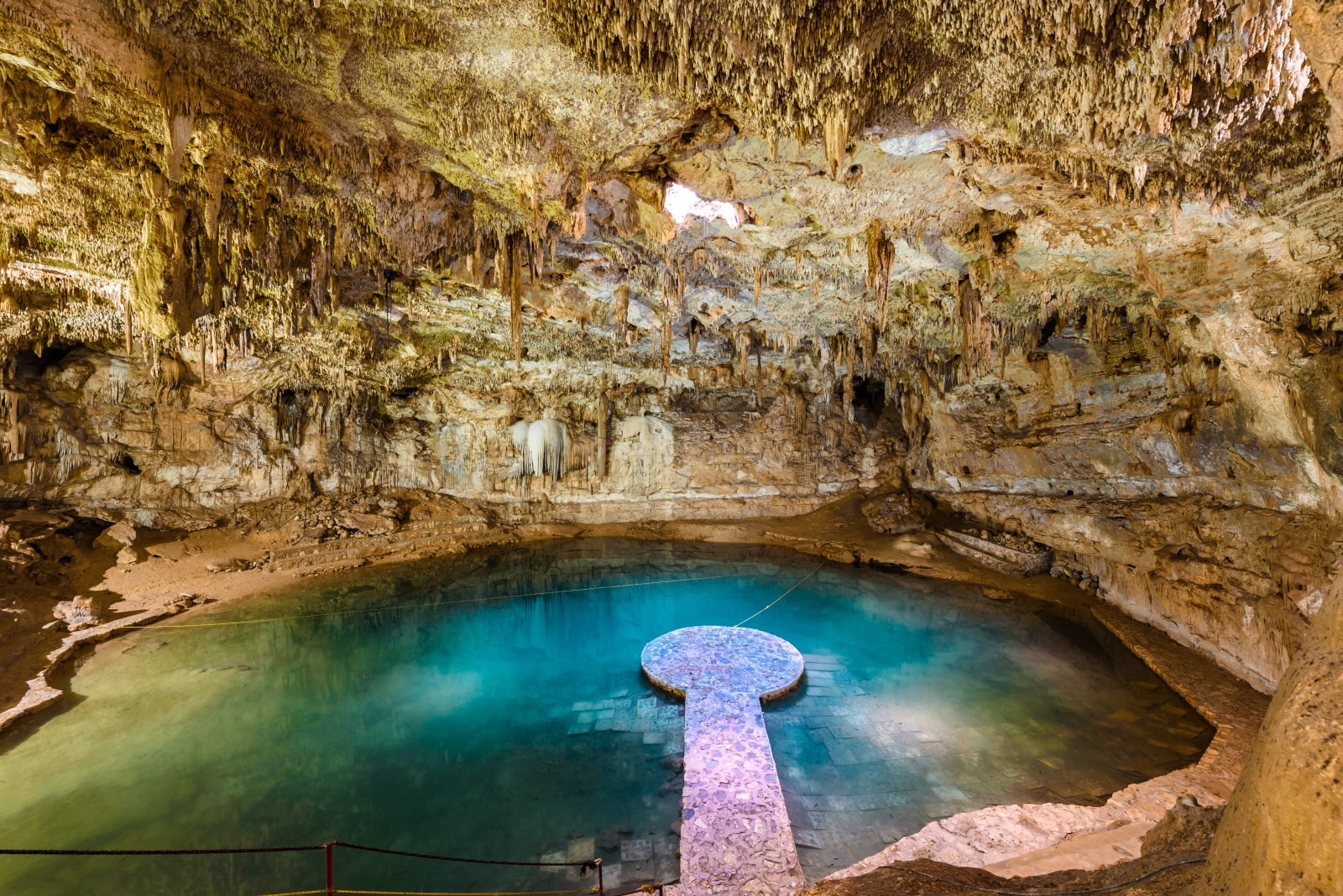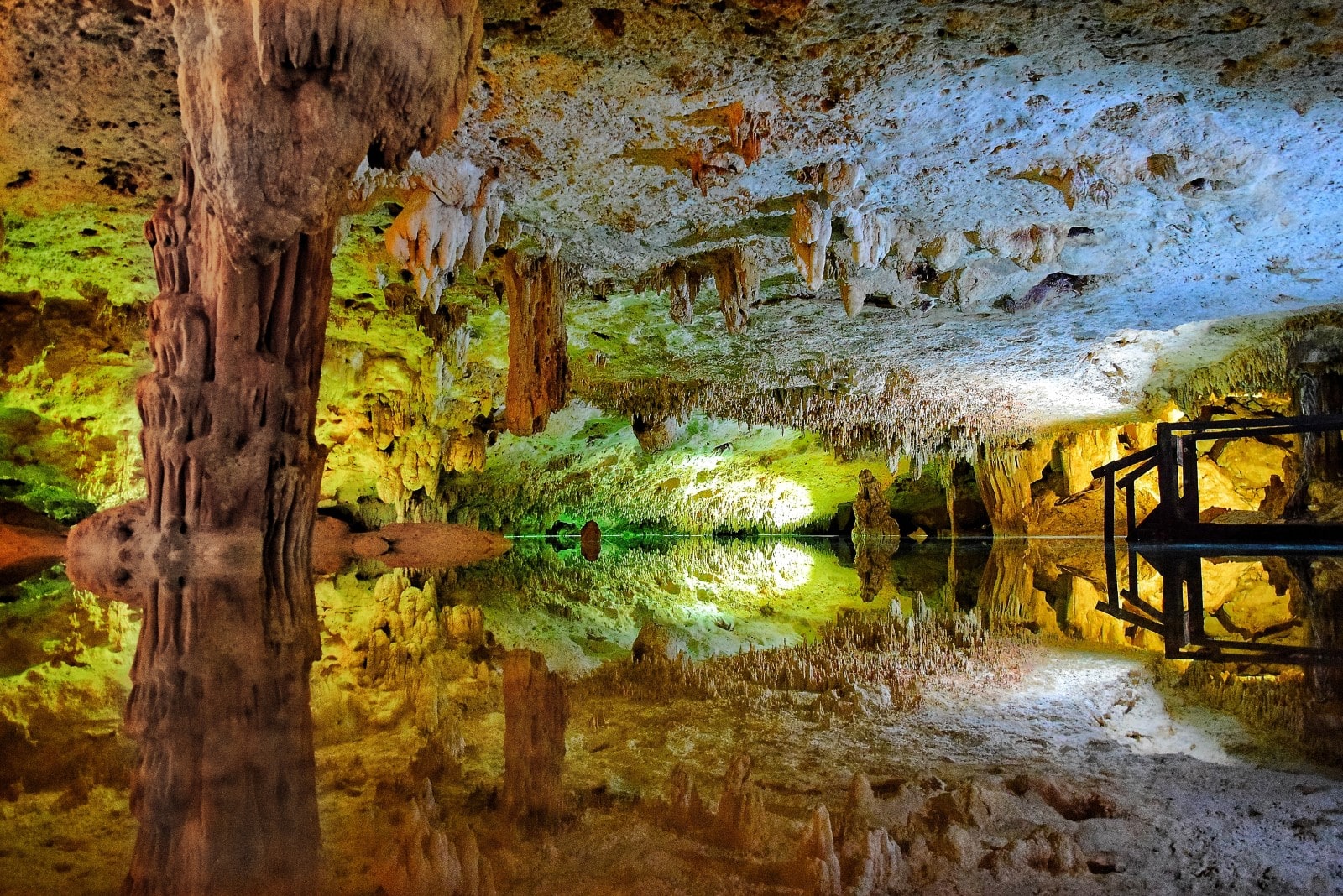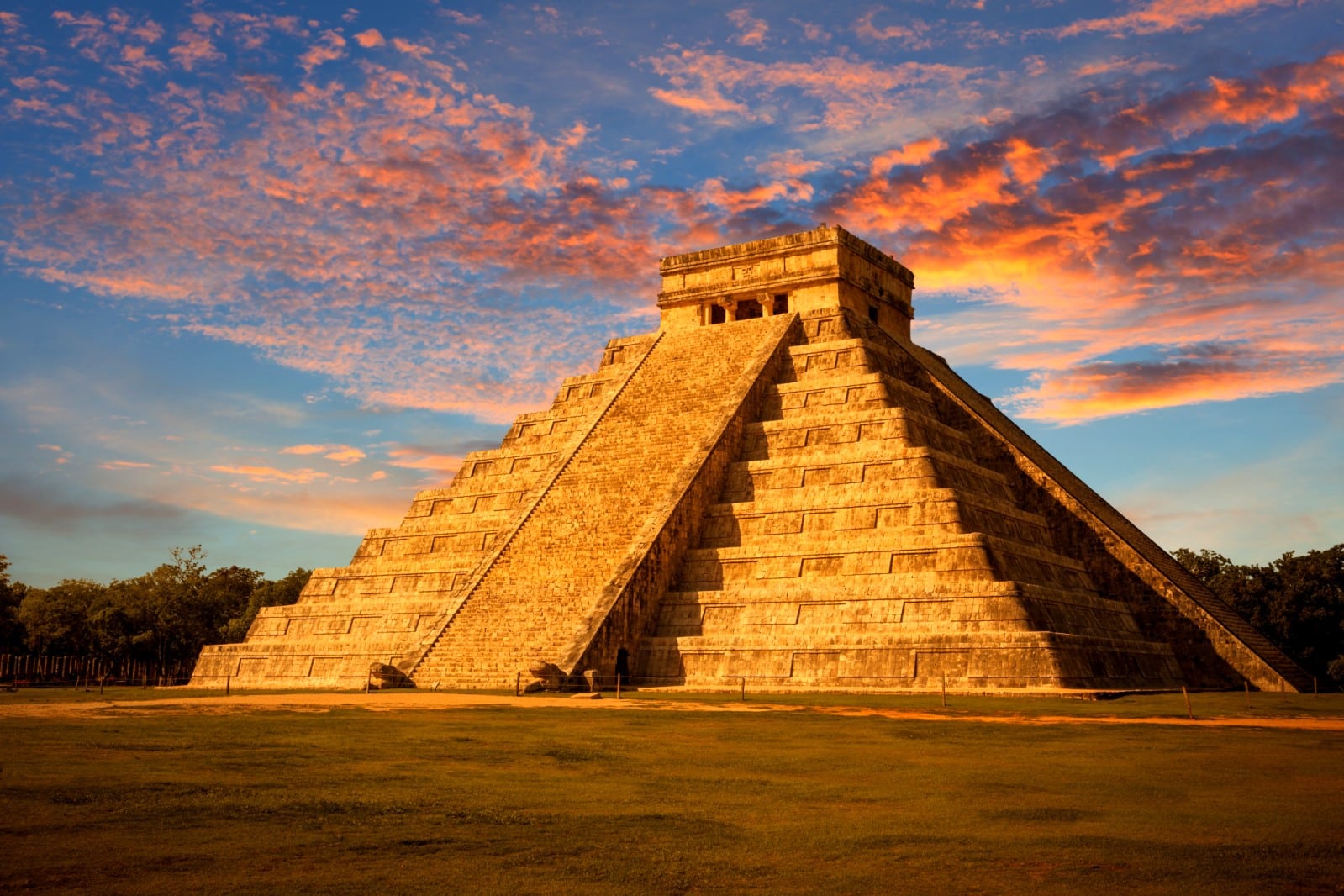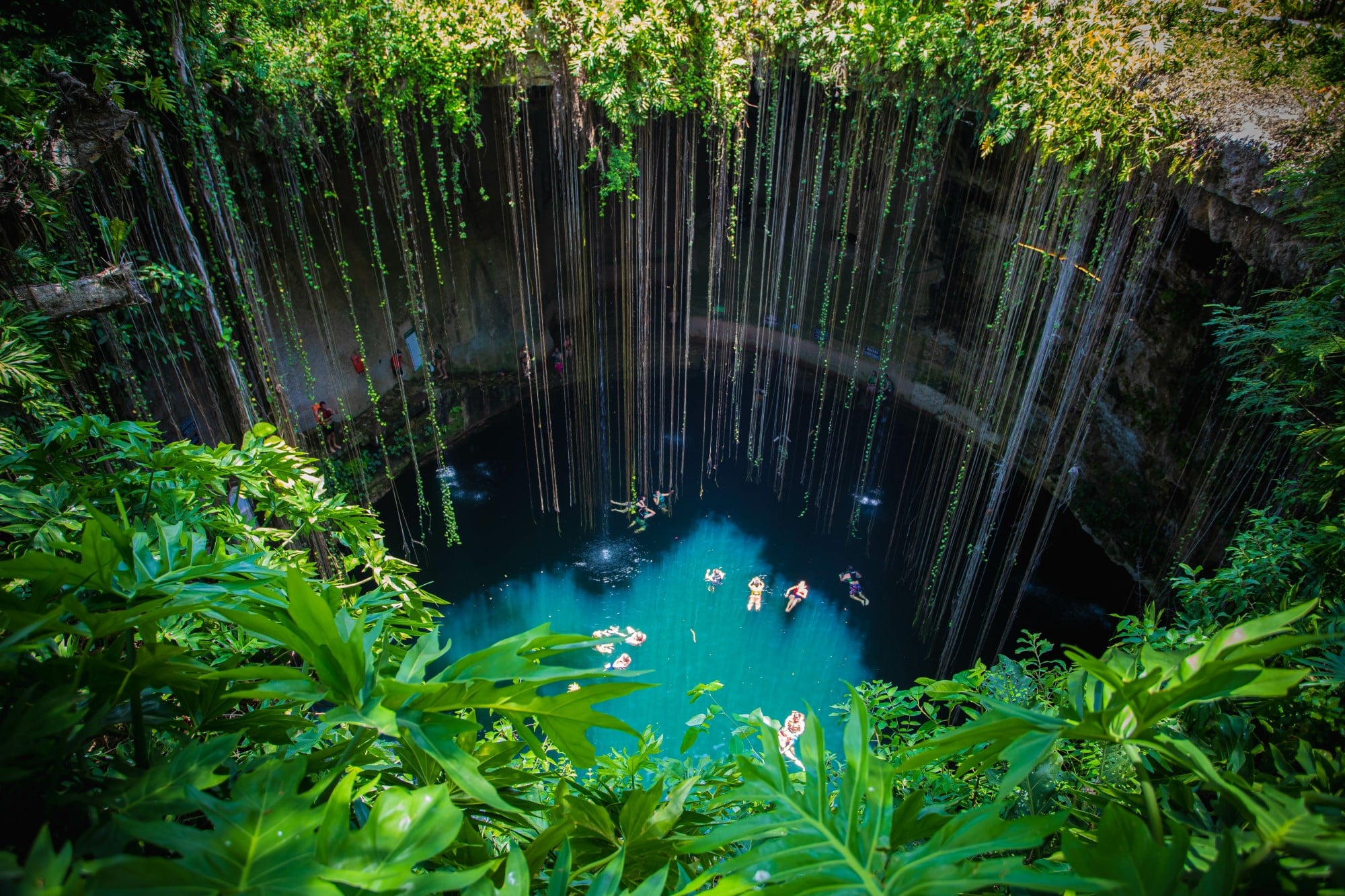
Yucatan’s Spectacular Cenotes are a natural pit or sinkhole resulting from the collapse of limestone bedrock that exposes groundwater underneath. Especially associated with the Yucatán Peninsula of Mexico, cenotes were sometimes used by the ancient Maya for sacrificial offerings.
The formation of cenotes is typically linked to the dissolution of soluble rocks (such as limestone, gypsum, and dolomite) and the subsequent structural collapse. This process can occur in several stages:
Dissolution of Rock: Rainwater, which is slightly acidic due to dissolved carbon dioxide from the atmosphere, seeps through the soil and becomes more acidic as it acquires more carbon dioxide from decaying organic matter. This acidified water then percolates through cracks and fissures in limestone, gradually dissolving the rock and creating underground voids and caverns.
Cavern Development: Over time, these caverns can grow larger as more rock is dissolved. In regions with extensive limestone formations, like the Yucatán Peninsula, vast underground cave systems can be formed.
Roof Collapse: When the ceiling of one of these caverns becomes too thin to support its own weight, it can collapse, exposing the water-filled cavern below. This creates the cenote, which can be open to the sky, semi-covered, or completely underground.
Cenotes were vital sources of water in the generally dry Yucatán Peninsula and held spiritual significance for the Maya, as they were considered gateways to the underworld and were used in various rituals.
Traveler Cenote Picks
Cenote Ik Kil
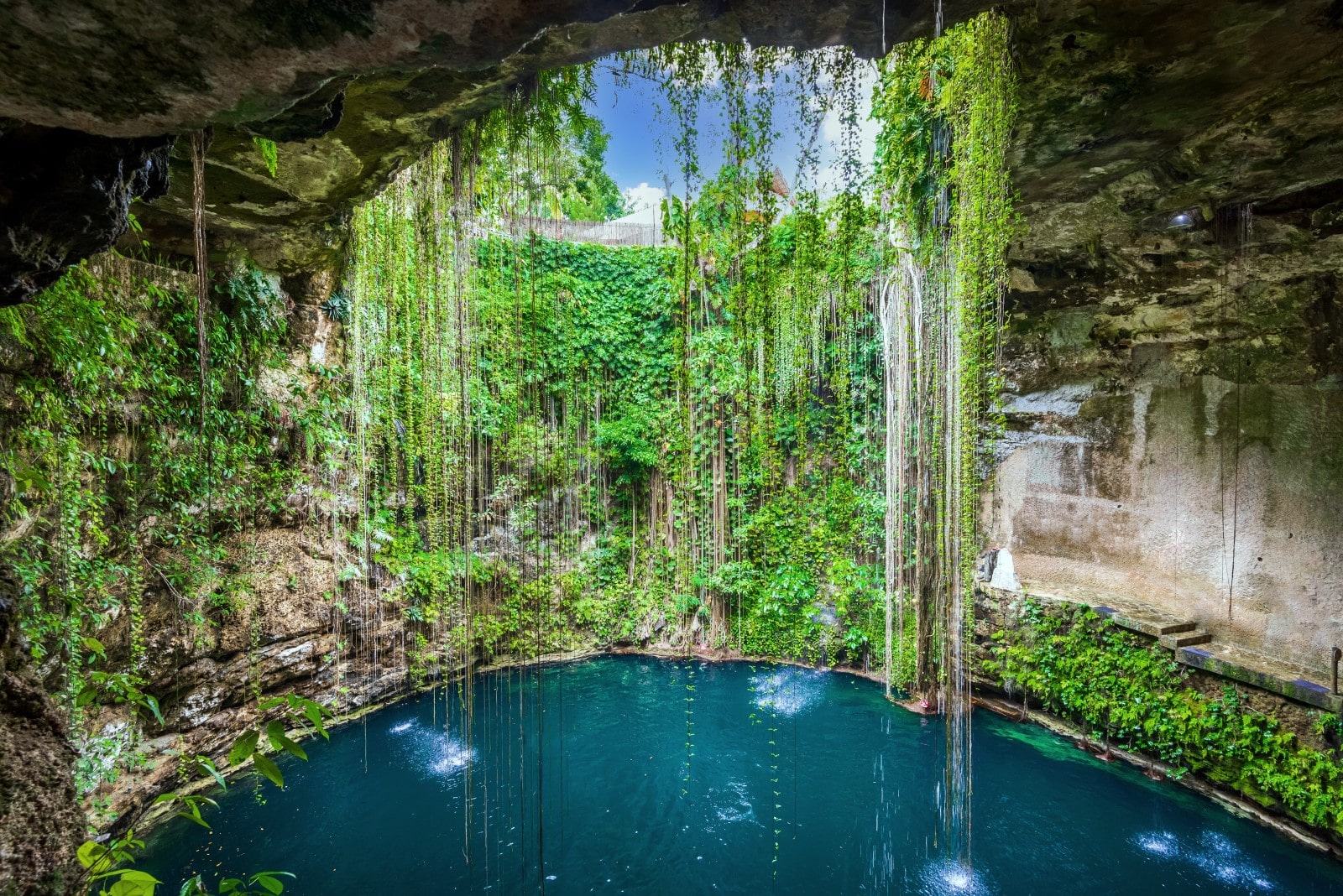
Cenote Ik Kil is a well-known cenote in Mexico, located in the northern center of the Yucatán Peninsula. It is part of the Ik Kil Archeological Park near Chichen Itza, one of the most famous Maya ruins. This cenote is particularly popular among tourists due to its stunning beauty and accessibility.
Location: Cenote Ik Kil is situated about 3 kilometers (1.8 miles) from the archaeological site of Chichen Itza and about 2 hhttps://www.traveler.com/chichen-itza/ours by car from the city of Cancún. The cenote is near the town of Piste in the state of Yucatán.
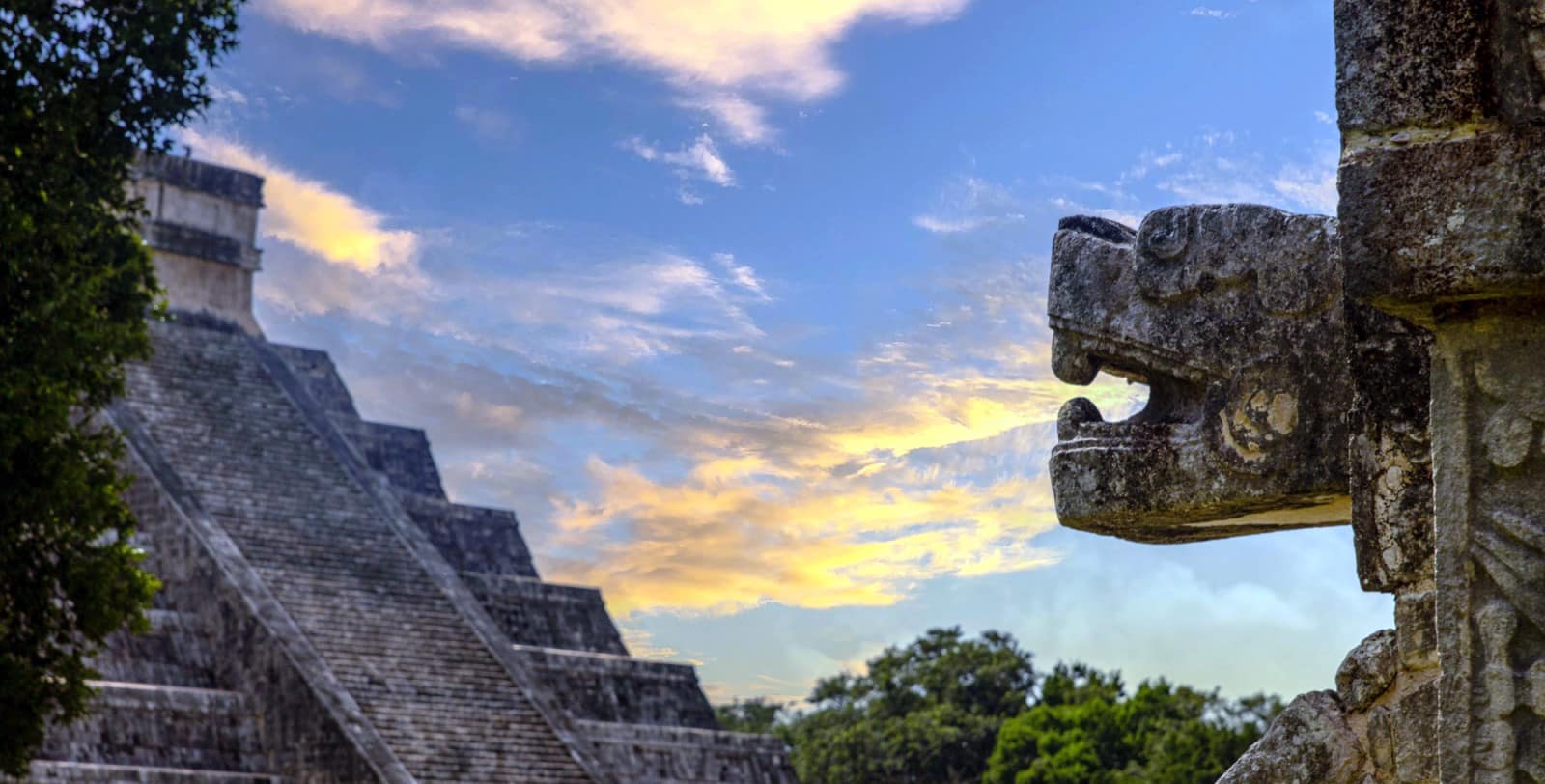
How to Get There:
- From Cancún or Playa del Carmen: The most common way to visit Cenote Ik Kil is by car or bus from Cancún or Playa del Carmen. There are also private shuttle services to Chichen Itza. It’s a drive of approximately 2 to 2.5 hours from Cancún. Buses frequently run to the site from these cities.
- From Mérida: Mérida, the capital of Yucatán state, is about 1.5 hours away by car. Buses also operate from Mérida to Chichen Itza, from where you can easily reach Cenote Ik Kil.
- Guided Tours: Many visitors opt for guided tours, especially if they are also planning to visit Chichen Itza. These tours usually include transportation to both the ruins and the cenote.
About Cenote Ik Kil: The cenote is about 60 meters in diameter and about 40 meters deep, with clear blue water perfect for swimming. Vines hang from the opening all the way down to the water surface, and there’s a waterfall, adding to its picturesque beauty. It’s often included in the itinerary of tourists visiting Chichen Itza due to its proximity and the refreshing experience it offers after exploring the ruins.
The site has amenities like a restaurant, changing rooms, and lockers, making it a convenient spot for tourists. However, it’s important to note that Cenote Ik Kil can get quite crowded due to its popularity, especially during peak tourist seasons.
Cenote Samulá
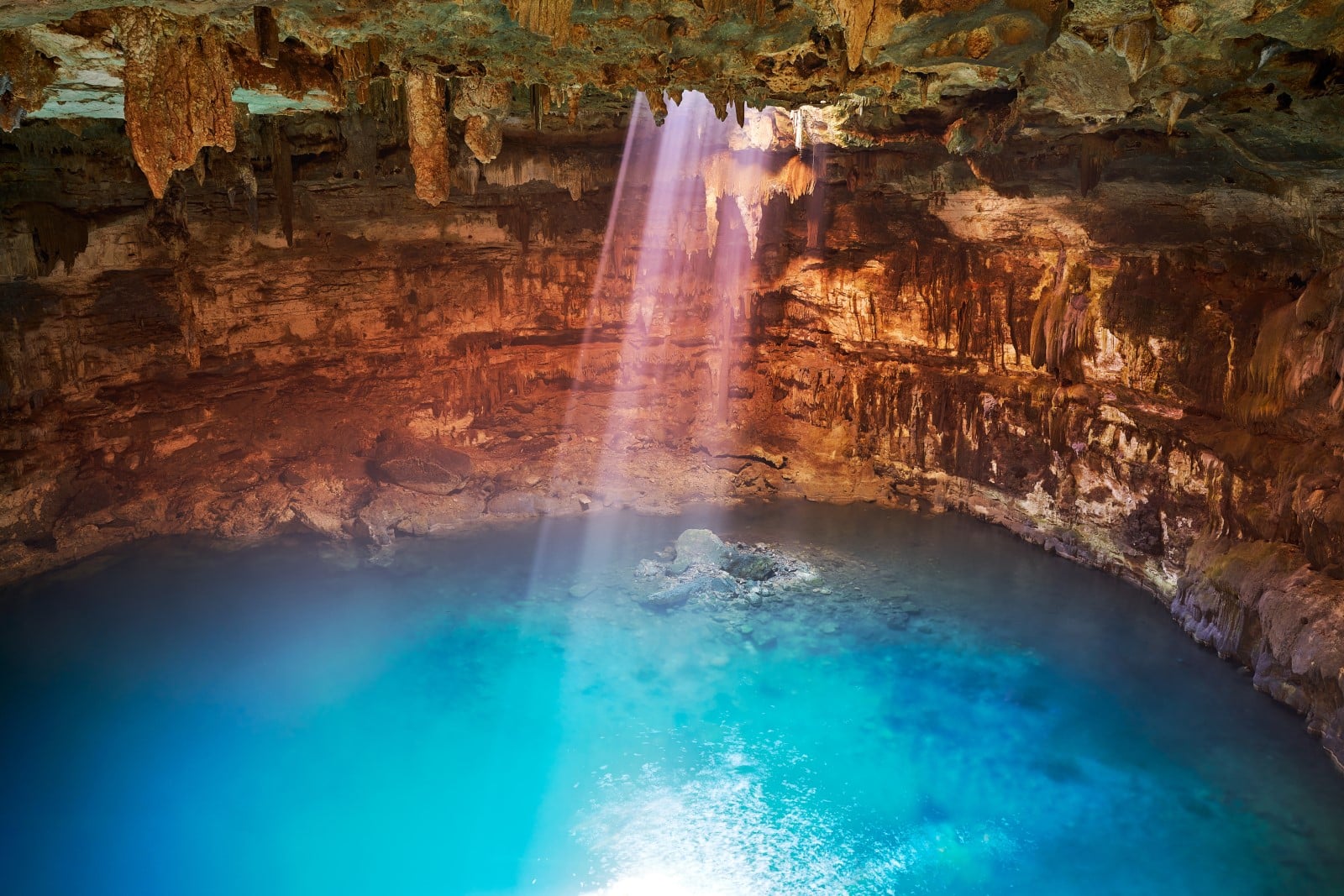
Cenote Samulá is another beautiful and popular cenote located in Mexico’s Yucatán Peninsula. It’s situated in the same area as Cenote Xkeken, near the town of Valladolid, which is a charming colonial town rich in history and culture.
Location: Cenote Samulá is in the village of Dzitnup, about 7 kilometers (around 4.3 miles) west of Valladolid. Valladolid itself is roughly in the middle of the Yucatán Peninsula and is a common stop for travelers exploring the region due to its proximity to various cenotes and Maya ruins.
How to Get There:
- From Valladolid: The most common access point to Cenote Samulá is from Valladolid. You can drive, take a taxi, or even ride a bicycle from Valladolid to the cenote. The route is well-marked and relatively easy to navigate.
- From Cancún or Playa del Carmen: If you’re coming from Cancún or Playa del Carmen, it’s about a 1.5 to 2-hour drive to Valladolid. From there, you can follow the directions to Cenote Samulá.
- Public Transportation: Buses and colectivos (shared taxis) are available from Valladolid, making it easy to reach the cenote even if you don’t have a private vehicle.
About Cenote Samulá: Cenote Samulá is known for its stunning underground setting. It’s a semi-open cenote, meaning it has a hole in the ceiling that lets in sunlight, creating ethereal light effects on the water. The roots of a large tree can be seen hanging from the opening, reaching down towards the water, which adds to the unique and mystical atmosphere of the place.
The water in Cenote Samulá is clear and refreshing, ideal for swimming. The cenote is less commercialized than some of the more famous ones like Ik Kil, which can make for a more tranquil and authentic experience. There are basic facilities like changing rooms and restrooms available for visitors.
Visiting Cenote Samulá can be a magical experience, especially when the sunlight streams through the opening in the cavern’s roof, illuminating the clear waters below. It’s a perfect example of the natural beauty and geological wonder that cenotes represent.
Suytun Cenote
Cenote Suytun is a captivating and relatively less crowded cenote located in the Yucatán Peninsula of Mexico. It’s known for its stunning underground cave-like structure and the remarkable light effects created by a hole in the roof of the cavern.
Location: Cenote Suytun is situated about 8 kilometers (approximately 5 miles) east of Valladolid, a historic town in the Yucatán. This location makes it easily accessible for visitors staying in Valladolid or those traveling between Cancún and Mérida.
How to Get There:
- From Valladolid: The cenote is a short drive from Valladolid. You can take a taxi or drive yourself. If you’re feeling adventurous, you can also rent a bicycle and ride to the cenote.
- From Cancún or Playa del Carmen: For those coming from coastal areas like Cancún or Playa del Carmen, the drive to Cenote Suytun is about 1.5 to 2 hours. Many visitors combine a trip to Cenote Suytun with a visit to Valladolid or Chichen Itza.
- Public Transportation: While public transportation options like buses or colectivos might be available, they may not take you directly to the cenote. Typically, a taxi from Valladolid would be the most convenient public transport option.
About Cenote Suytun: Cenote Suytun is particularly famous for its circular platform in the center, which creates an almost surreal and photogenic scene when the sunlight beams down through the hole in the cavern’s roof, illuminating the platform and the surrounding water. The water is clear and calm, making it suitable for swimming, although it’s relatively shallow compared to some other cenotes.
The cenote has an ethereal feel, with stalactites adorning the ceiling and the play of light and shadow creating a mystical ambiance. It’s an excellent spot for photography due to its unique features.
Facilities at Cenote Suytun include changing rooms, restrooms, and a small restaurant. The infrastructure around the cenote is well-developed, making it accessible for most visitors.
Cenote Casa Tortuga
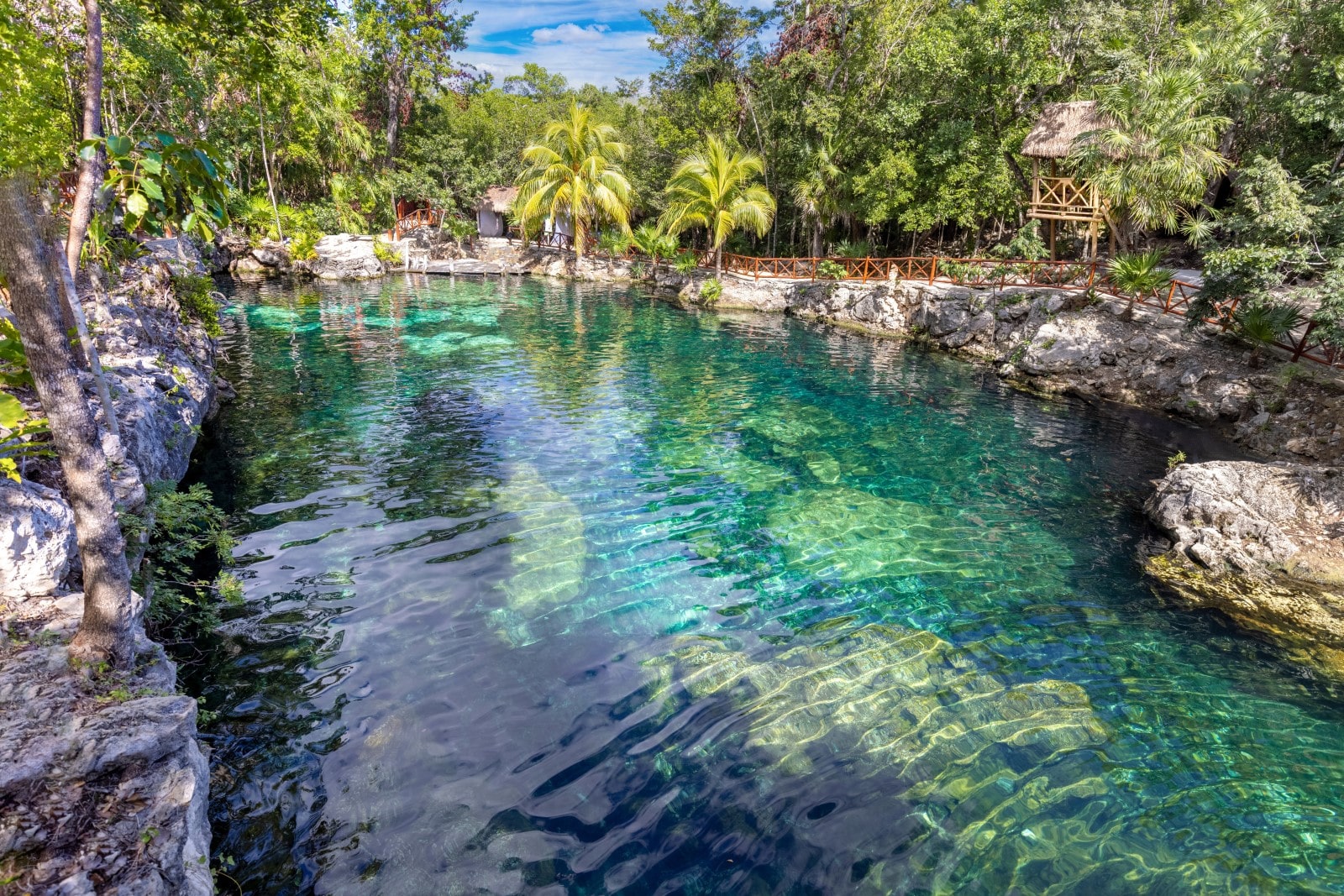
Cenote Casa Tortuga is a fascinating cenote complex located in Tulum, on the Yucatán Peninsula of Mexico. It’s particularly notable for being a system of four different cenotes, offering a unique experience to explore multiple water-filled sinkholes in one location.
Location: Cenote Casa Tortuga is situated in Tulum, a town famous for its beaches and well-preserved ruins of an ancient Maya port city. Tulum is located on the Caribbean coastline of the Yucatán Peninsula.
How to Get There:
- From Tulum: Cenote Casa Tortuga is easily accessible from the town of Tulum. You can take a taxi, rent a bike, or even drive if you have a rental car. The distance is not far from the main area of Tulum.
- From Playa del Carmen or Cancún: If you are coming from Playa del Carmen or Cancún, you can drive to Tulum, which takes about 45 minutes from Playa del Carmen and around 1.5 to 2 hours from Cancún. Once in Tulum, follow the directions to Cenote Casa Tortuga.
- Public Transportation: Buses and colectivos (shared vans) are available from various points in the Riviera Maya to Tulum. From Tulum, you can get a taxi to the cenote.
About Cenote Casa Tortuga: The Cenote Casa Tortuga complex offers a diverse cenote experience, as it includes different types of cenotes — open-air, semi-open, and cave cenotes. This variety allows visitors to experience the different atmospheres and formations that cenotes can offer. The clear waters are ideal for swimming and snorkeling, with opportunities to see interesting rock formations and local wildlife.
Each cenote in the Casa Tortuga complex has its own unique characteristics. Some are more open and great for swimming and relaxing, while others offer more adventurous experiences like exploring caves and tunnels.
The site is well-developed for tourism, with facilities such as changing rooms, restrooms, and rental equipment for snorkeling. Guided tours are available, which can enhance the experience by providing information about the geology and ecology of the cenotes.
Chac-Mool Cenote
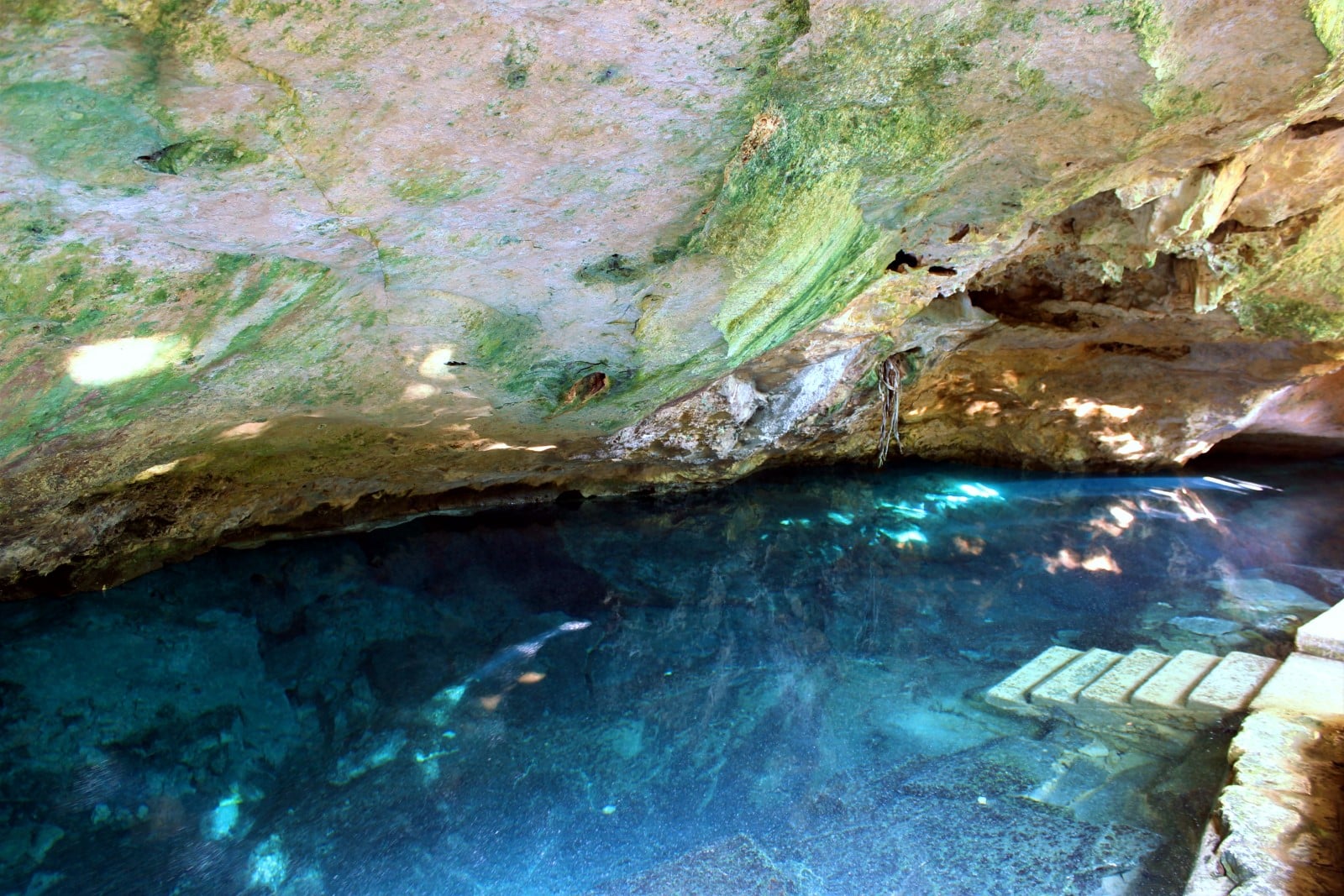
Cenote Chac Mool, located near Playa del Carmen on the Yucatán Peninsula of Mexico, is one of the most famous cenotes in the area, especially among scuba diving enthusiasts. It’s known for its unique underwater environments, including the halocline phenomenon and stunning light effects.
Location: Cenote Chac Mool is situated just a few kilometers south of Puerto Aventuras and about 20 to 30 minutes from Playa del Carmen. Its location along the Riviera Maya makes it easily accessible from major tourist centers like Cancún and Tulum.
How to Get There:
- From Playa del Carmen: The drive from Playa del Carmen to Cenote Chac Mool is straightforward, taking about 20 to 30 minutes by car. You can rent a car, take a taxi, or join a guided tour that includes transportation.
- From Cancún or Tulum: If you’re traveling from Cancún, it will take about an hour to reach the cenote. From Tulum, the journey is approximately 45 minutes. The cenote is located near Highway 307, the main coastal road.
- Public Transportation: You can also use colectivos (shared vans) that run along Highway 307. However, reaching the cenote’s exact location may require a short taxi ride from the highway.
About Cenote Chac Mool: This cenote is particularly famous for cave diving. It has two main entries leading to a system of underwater caves and passageways. One of the key attractions for divers in Cenote Chac Mool is the halocline effect — a visually fascinating phenomenon that occurs where the fresh water and salt water meet, creating a blurry layer.
The cenote is also known for its incredible light effects, especially noticeable around noon when sunlight streams through the openings, creating ethereal beams underwater. This natural light show, combined with the rock formations and crystal-clear waters, makes it a spectacular sight.
Facilities at Cenote Chac Mool include parking, restrooms, and areas for gearing up for dives. While it’s a paradise for scuba divers, snorkelers can also enjoy the beauty of the cenote from the surface.
Cenote Chac Mool offers a unique and memorable experience, showcasing the hidden underwater wonders of the Yucatán Peninsula. It’s an essential visit for those interested in cave diving and exploring the natural beauty of the region’s cenotes.
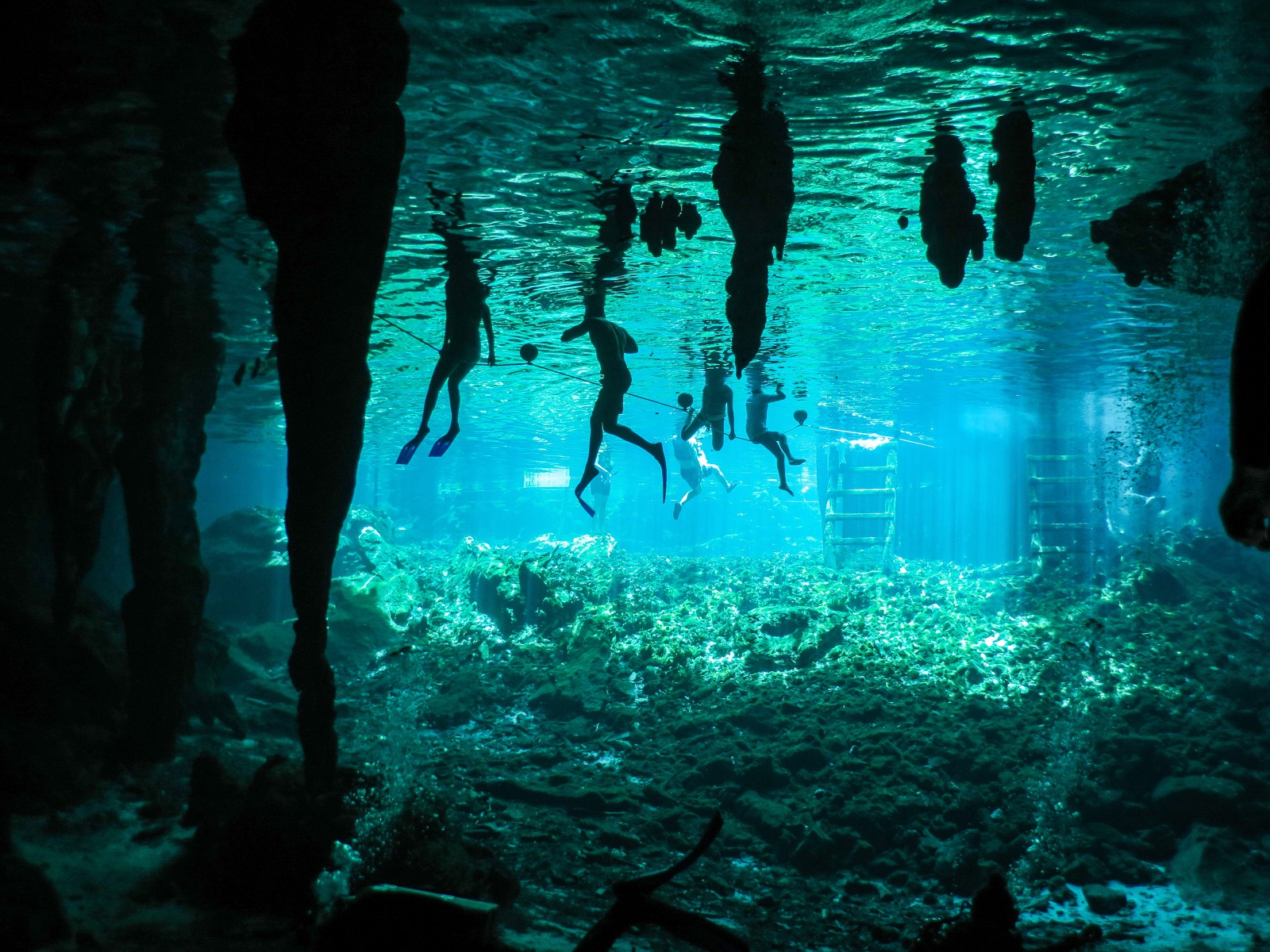
Gran Cenote
Gran Cenote is a renowned natural attraction located approximately 5 kilometers (3.1 miles) northwest of Tulum, Mexico, along the highway leading to the Coba ruins. It’s celebrated for its crystal-clear turquoise waters, intricate cave systems, and diverse aquatic life, including turtles and small fish. The cenote offers excellent opportunities for swimming, snorkeling, and diving, making it a favorite spot for both casual visitors and adventure enthusiasts.
Getting to Gran Cenote:
- By Car: Renting a car provides flexibility and convenience. From Tulum town center, drive northwest on the highway towards Coba; the cenote is well-signposted and offers free parking. The journey takes about 10 minutes.
- By Bicycle: For a more eco-friendly option, consider biking. The ride from Tulum town center to Gran Cenote takes approximately 30 minutes, primarily along a straight route on the main road (QROO 109). Bikes can be rented in Tulum for around $8 USD per day.
- By Taxi: Taxis are readily available in Tulum. A one-way trip to Gran Cenote typically costs around 100 to 150 MXN pesos. It’s advisable to arrange for the taxi to wait or schedule a return pickup, as finding transportation back can be challenging.
- By Colectivo: Local shared vans, known as colectivos, travel the route between Tulum and Coba. Inform the driver of your destination, and they will drop you near Gran Cenote. This is a budget-friendly option but may require some walking from the drop-off point.
Where to Stay:
Tulum offers a variety of accommodations to suit different preferences and budgets. Here are some options:
- Anastasia Tulum Luxury: Located in Tulum Town, this hotel provides a blend of luxury and convenience. It features a rooftop terrace with panoramic views and is close to local eateries and the ADO bus station.
- Beachfront Hotels: For those seeking proximity to the sea, Tulum’s Hotel Zone offers numerous beachfront properties. Staying here provides easy access to both the beach and attractions like Gran Cenote.
- Budget-Friendly Hostels: Tulum Pueblo (downtown area) has several hostels and guesthouses that offer affordable rates and a chance to experience local culture.
Tips for Visiting Gran Cenote:
Operating Hours: Open daily from 8:10 AM to 4:45 PM, with the last entry at 4:15 PM. Visiting early in the morning or late in the afternoon can help you avoid crowds.
Entrance Fee: As of January 2025, the entrance fee is 500 MXN pesos per person. Additional services like locker rentals (30 MXN), life jackets (50 MXN), and snorkel equipment (80 MXN) are available for a fee. It’s recommended to bring cash, preferably in Mexican pesos, as credit card facilities may not be available.
Facilities: Amenities include restrooms, outdoor showers (mandatory before entering the water), lockers, and picnic areas. There’s also a small shop selling snacks and drinks, and you’re welcome to bring your own food.
Regulations: To protect the delicate ecosystem, visitors are required to shower before entering the cenote and are prohibited from using sunscreen or insect repellent. It’s advisable to bring a hat or wear protective clothing to shield against the sun.
Cenote Dos Ojos
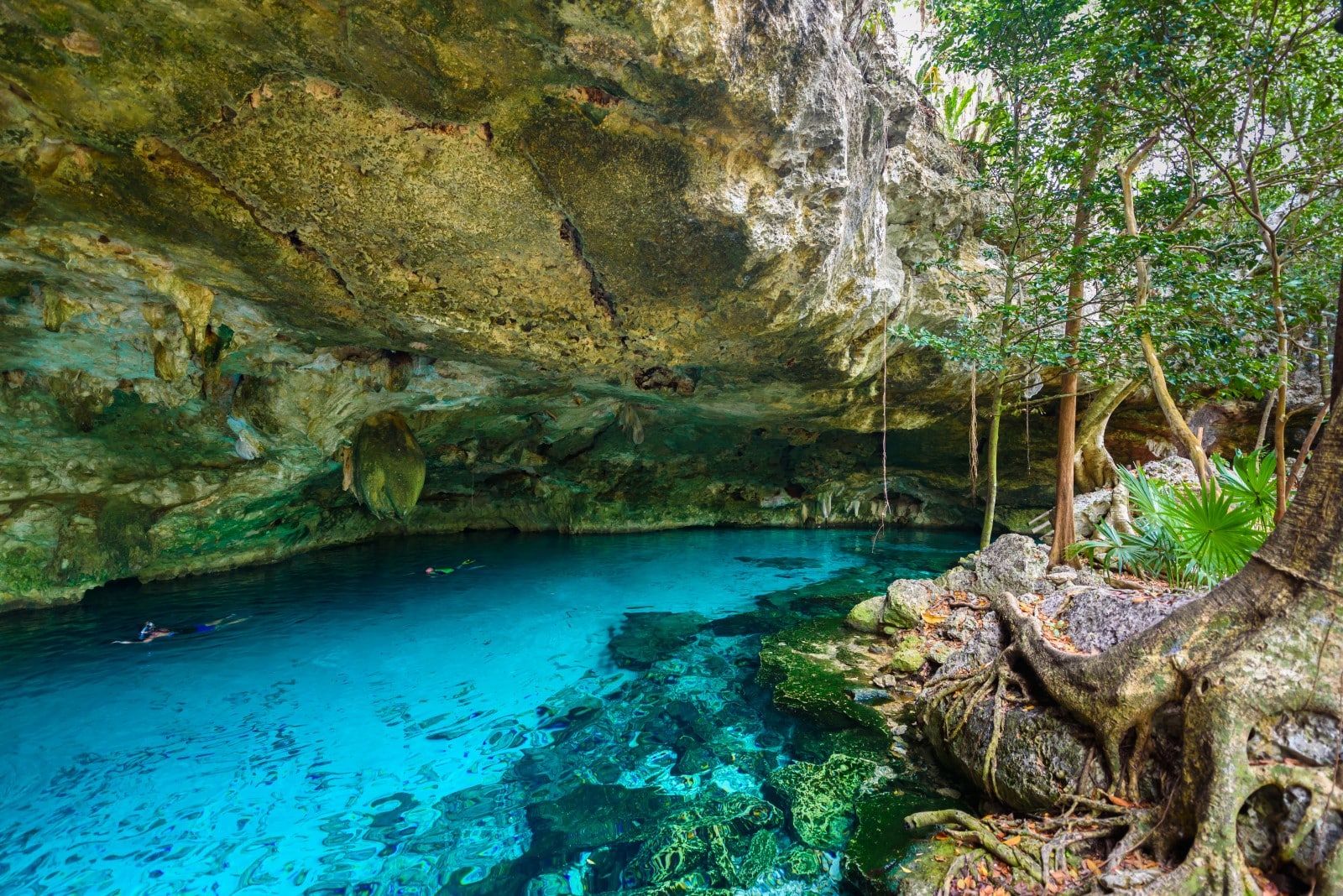
Cenote Dos Ojos (meaning “Two Eyes” in Spanish) is one of the most famous and spectacular cenotes in the Yucatán Peninsula of Mexico, renowned for its stunning underwater caves and clear blue waters. The name “Dos Ojos” refers to two neighboring cenotes connected by a large cavern zone, which resemble two large eyes from above.
Location: Cenote Dos Ojos is located just north of Tulum and south of Playa del Carmen, in close proximity to the town of Akumal. It’s part of a larger cave system known as the Dos Ojos System, which is one of the longest underwater cave systems in the world.
How to Get There:
- From Tulum: The cenote is about a 20-minute drive from Tulum. You can rent a car, take a taxi, or use local colectivos (shared minibuses).
- From Playa del Carmen or Cancún: From Playa del Carmen, it’s about a 40-minute drive, and from Cancún, it’s around 1.5 hours. You can drive, take a bus, or join a guided tour.
- Public Transportation: Public buses and colectivos also run along the main highway (307) and can drop you near the entrance to the cenote. From there, you might have a short walk or a taxi ride to the cenote itself.
About Cenote Dos Ojos: Cenote Dos Ojos is particularly popular among snorkelers and scuba divers due to its clear waters and stunning underwater formations. The cenote features two main sinkholes (the “two eyes”), connected by a long passageway, with incredible visibility in the water.
- Snorkeling: The cenote offers a fantastic snorkeling experience, as the water is crystal clear and there are plenty of interesting rock formations and marine life to see.
- Diving: For scuba divers, particularly those interested in cave diving, Cenote Dos Ojos offers one of the most extraordinary underwater experiences in the world. The cave system is extensive and well-known for its beauty, water clarity, and the fascinating light effects that occur when sunlight penetrates the water.
- Amenities: The site is equipped with facilities such as restrooms, changing rooms, and a parking area. There are also guides and equipment available for rent.
El Jardín del Edén Cenote

El Jardín del Edén Cenote, also known as Cenote Eden or Ponderosa Cenote, is a stunning open-air cenote located in the Riviera Maya region of Mexico’s Yucatán Peninsula. It’s known for its natural beauty, crystal-clear waters, and lush surroundings, reminiscent of the biblical “Garden of Eden.”
Location: El Jardín del Edén Cenote is situated close to Playa del Carmen and just a few kilometers from Puerto Aventuras. Its location makes it easily accessible from major tourist destinations in the area, including Cancún and Tulum.
How to Get There:
- From Playa del Carmen: The cenote is approximately a 20 to 30-minute drive from Playa del Carmen. You can reach it by car, taxi, or via a guided tour.
- From Cancún or Tulum: From Cancún, it’s about an hour’s drive, while from Tulum, it’s approximately 40 minutes. The cenote is conveniently located near the Federal Highway 307, making it easily accessible.
- Public Transportation: Colectivos (shared vans) are a common and economical way to travel. You can catch a colectivo from Playa del Carmen or Tulum heading towards the cenote.
About El Jardín del Edén Cenote: This cenote is a large, open sinkhole surrounded by lush vegetation, creating a serene and picturesque setting. The water is incredibly clear, making it ideal for snorkeling and swimming. The depth varies across the cenote, with some areas deep enough for cliff jumping.
- Snorkeling and Swimming: The cenote’s clear waters provide excellent visibility for snorkeling, with a chance to see a variety of fish and underwater formations.
- Diving: While not as famous for diving as some other cenotes in the region, El Jardín del Edén still offers a good diving experience, especially for beginners.
- Amenities: The site has basic amenities like restrooms, changing areas, and a small snack bar. There are also picnic tables and areas where visitors can relax and enjoy the natural setting.
- Flora and Fauna: The surrounding garden and the clear waters of the cenote are home to a variety of plant and animal life, adding to the cenote’s natural charm.
El Jardín del Edén Cenote is a popular spot known for its relaxing atmosphere and natural beauty. It’s an ideal destination for those looking to enjoy a day of swimming and snorkeling.
X’Canche Cenote
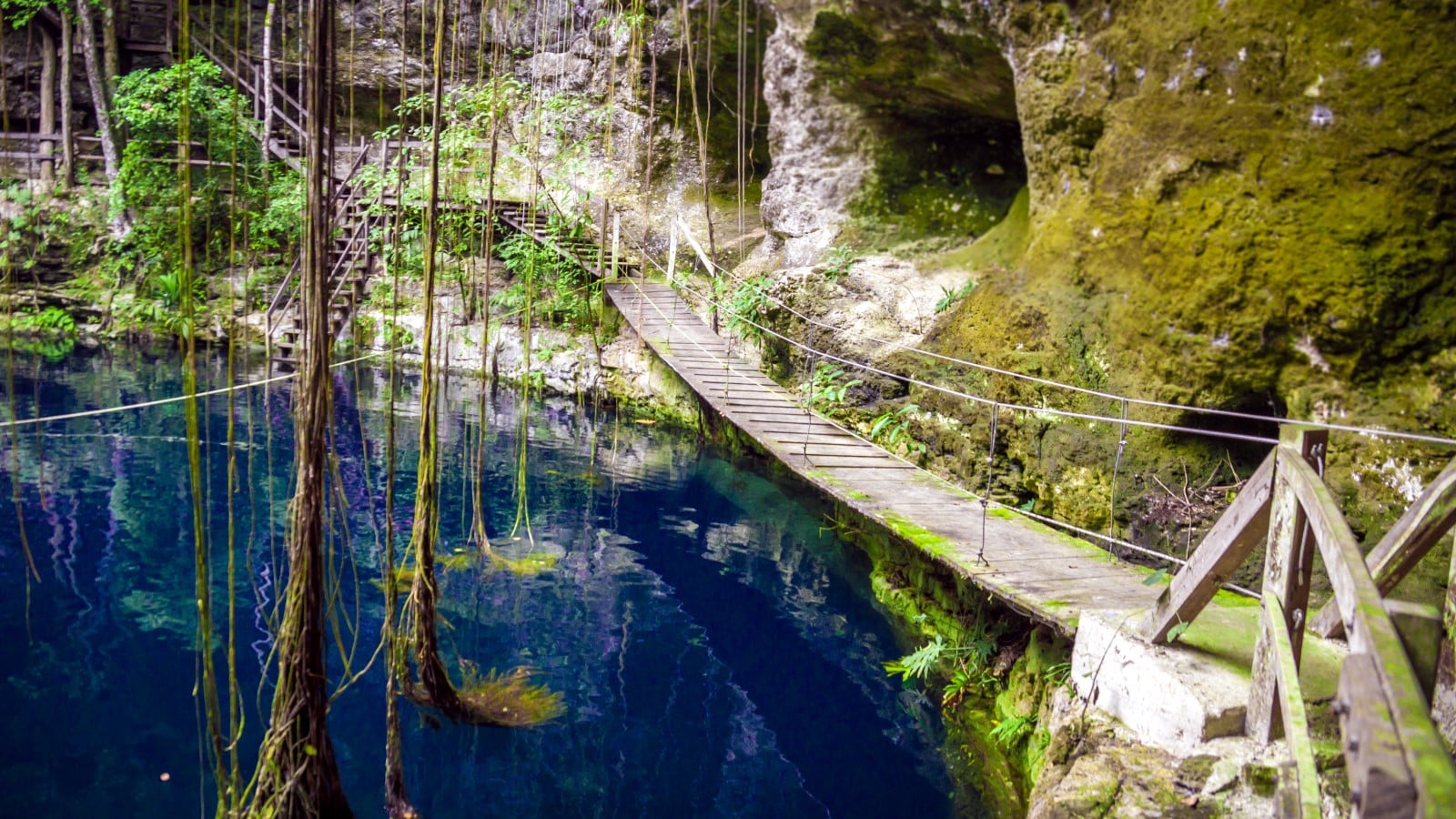
X’Canche Cenote is a stunning natural sinkhole located in the Yucatán Peninsula of Mexico, near the ancient Maya city of Ek Balam. Known for its serene and somewhat off-the-beaten-path location, it offers visitors a more tranquil and natural cenote experience compared to some of the more tourist-heavy cenotes in the region.
Location: Cenote X’Canche is situated very close to the archaeological site of Ek Balam, approximately 30 kilometers (about 18.6 miles) north of Valladolid, a colonial city in the Yucatán state.
How to Get There:
- From Valladolid: The journey from Valladolid to Ek Balam, where Cenote X’Canche is located, takes about 30 to 40 minutes by car. You can rent a car, take a taxi, or use public transportation.
- From Cancún or Playa del Carmen: If you’re coming from Cancún or Playa del Carmen, the drive is longer, taking approximately 2 to 2.5 hours. The route is straightforward, heading inland from the coast.
- Public Transportation: Buses and colectivos are available from Valladolid to Ek Balam. Once at the Ek Balam site, you may need to walk or take a bicycle taxi to reach the cenote, which is about 1.5 kilometers (just under a mile) from the archaeological site’s entrance.
About Cenote X’Canche: Cenote X’Canche is a large, open-air cenote surrounded by natural vegetation, offering a refreshing and picturesque swimming experience. The cenote is less commercialized than others in the region, providing a more authentic and peaceful atmosphere.
- Swimming and Relaxation: The cenote is perfect for swimming, with clear, cool waters. There are areas where you can relax and enjoy the natural surroundings.
- Rappelling and Zip-lining: For the more adventurous, there are options for rappelling and zip-lining at the cenote, adding an element of excitement to the visit.
- Amenities: Basic amenities like restrooms and changing rooms are available. There may also be options for renting life jackets and other swimming gear.
Visiting Cenote X’Canche offers a wonderful opportunity to combine a trip to a historical Maya site with the natural beauty of a cenote. The close proximity to Ek Balam makes it a convenient and rewarding addition to a day exploring the ruins.
Cenote Azul
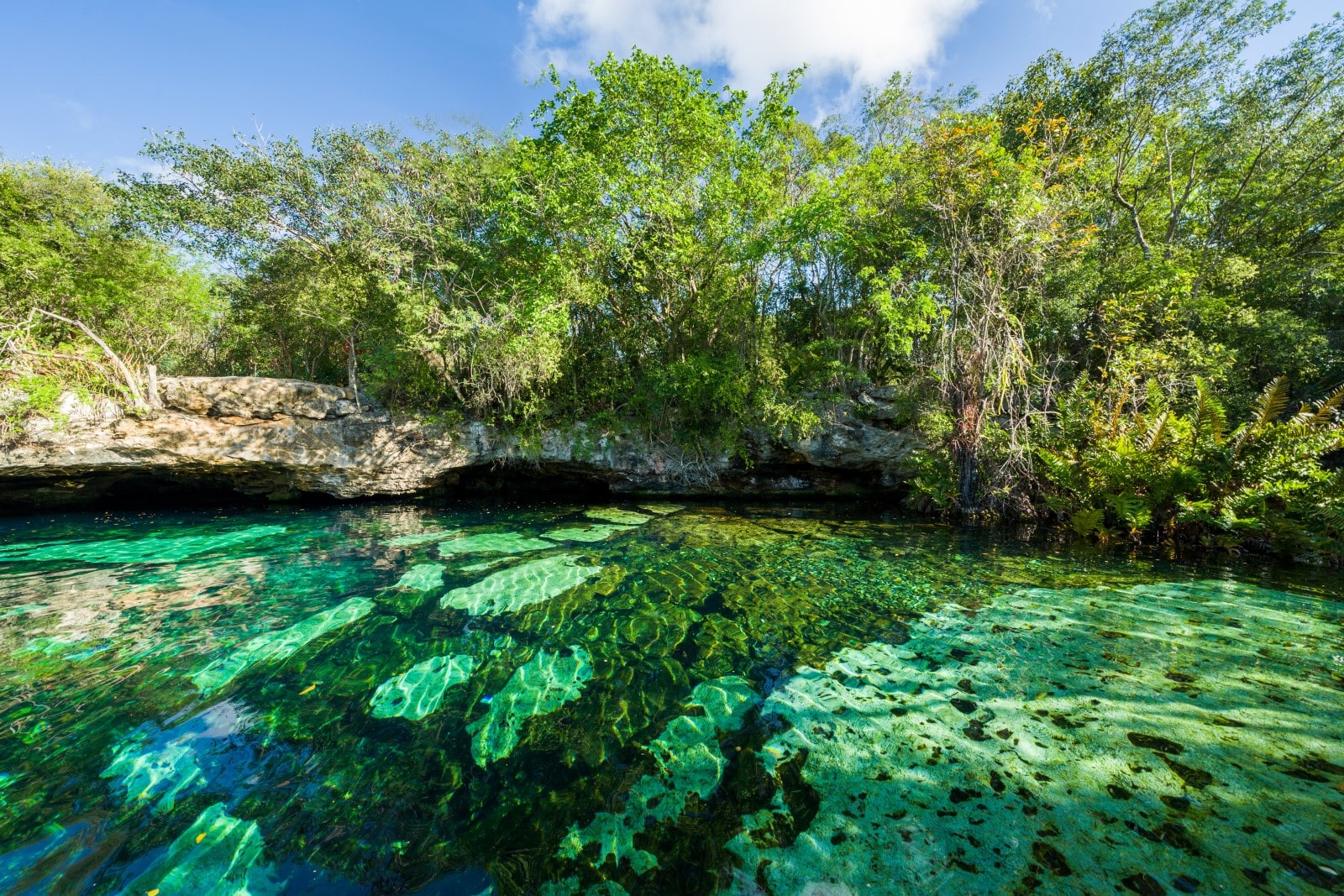
Cenote Azul, which translates to “Blue Cenote” in English, is a popular natural swimming spot located in the Riviera Maya region of Mexico’s Yucatán Peninsula. It is known for its stunning clear blue waters and serene natural setting.
Location: Cenote Azul is situated near Playa del Carmen, just a short distance from the town of Puerto Aventuras. It’s conveniently located close to the Federal Highway 307, making it easily accessible from major tourist destinations like Cancún and Tulum.
How to Get There:
- From Playa del Carmen: The cenote is approximately a 15 to 20-minute drive south from Playa del Carmen. You can reach it by car, taxi, or by taking a colectivo (shared van).
- From Cancún or Tulum: From Cancún, the drive to Cenote Azul takes about an hour, while from Tulum, it’s approximately 30 to 40 minutes. Again, you can use a rental car, taxi, or colectivo.
- Public Transportation: Colectivos that run along the Federal Highway 307 between Playa del Carmen and Tulum can drop you near the entrance of Cenote Azul.
About Cenote Azul: Cenote Azul is an open-air cenote, featuring a large and deep main pool with various smaller pools and areas around it. It’s surrounded by lush vegetation, adding to its natural charm.
- Swimming and Snorkeling: The cenote is ideal for swimming and snorkeling. Its clear blue waters offer good visibility to see the fish and underwater formations. The depth varies in different parts, making it suitable for both casual swimmers and those who like to dive from higher points.
- Family-Friendly Environment: Cenote Azul is known for being family-friendly, with shallow areas suitable for children and deeper sections for adults.
- Amenities: The site has basic amenities such as restrooms and changing areas. There are also picnic tables and shaded areas where visitors can relax.
- Accessibility: Compared to some of the more remote cenotes, Cenote Azul is known for its easy accessibility and convenience, especially for those staying in nearby tourist centers.
Cenote Cristalino
Cenote Cristalino is a beautiful open-air cenote located in the Riviera Maya region of the Yucatán Peninsula, near Playa del Carmen in Mexico. It’s known for its clear, fresh waters and natural setting, making it a popular spot for both locals and tourists.
Location: Cenote Cristalino is situated close to Playa del Carmen, just a few kilometers south of the town. It’s near other well-known cenotes like Cenote Azul and Cenote Eden (Jardín del Edén), forming part of a cluster of cenotes that are easily accessible from the main tourist areas along the Riviera Maya.
How to Get There:
- From Playa del Carmen: The cenote is about a 15-20 minute drive from Playa del Carmen. You can take a taxi, rent a car, or even use local colectivos (shared minibuses).
- From Cancún or Tulum: From Cancún, it’s about an hour’s drive, and from Tulum, it’s around 40 minutes. The cenote is located near the Federal Highway 307, which is the main road that runs along the Caribbean coast of the Yucatán Peninsula.
- Public Transportation: Buses and colectivos that run along Highway 307 between Playa del Carmen and Tulum can drop you near the entrance of the cenote. From there, it’s a short walk to the entrance.
About Cenote Cristalino: Cenote Cristalino is an open cenote, characterized by its large, clear water pool surrounded by rock formations and lush vegetation. It offers a refreshing swimming experience in a natural and serene environment.
- Swimming and Snorkeling: The clear waters of Cenote Cristalino are ideal for swimming and snorkeling. You can see small fish and the underwater rock formations. The cenote has areas of varying depth, suitable for both novice swimmers and those who prefer deeper waters.
- Natural Environment: The cenote is set in a natural environment, with plenty of vegetation around, adding to the sense of tranquility and connection with nature.
- Amenities: The site has basic amenities like restrooms and changing rooms. There might be a small fee for entry and additional services like life jacket rental.
Cenote Cristalino is less commercialized compared to some of the larger cenotes in the area, offering a more relaxed and intimate experience. It’s a great place to visit for a few hours of swimming and enjoying the natural beauty of the Riviera Maya.
Cenote Ponderosa
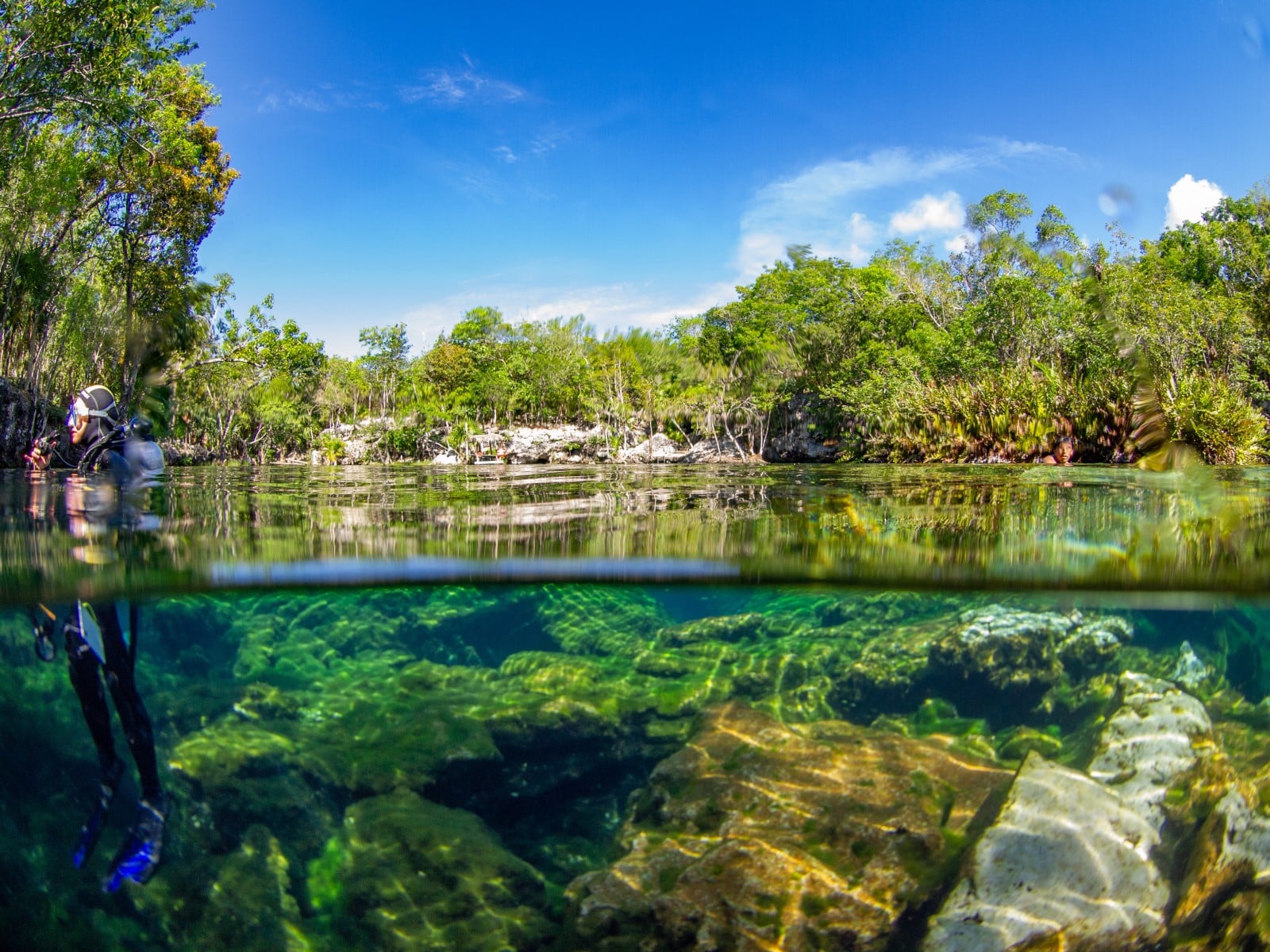
Cenote Ponderosa, also known as Cenote Eden or Jardín del Edén, is a beautiful open-air cenote located in the Riviera Maya region of Mexico’s Yucatán Peninsula. It’s known for its crystal-clear waters and lush surroundings, offering a serene natural swimming experience.
Location: Cenote Ponderosa is situated close to Playa del Carmen, just a few kilometers from Puerto Aventuras. Its location makes it easily accessible from major tourist destinations such as Cancún and Tulum.
How to Get There:
- From Playa del Carmen: The cenote is approximately a 20 to 30-minute drive from Playa del Carmen. You can reach it by car, taxi, or via a guided tour.
- From Cancún or Tulum: From Cancún, it’s about an hour’s drive, while from Tulum, it’s approximately 40 minutes. The cenote is conveniently located near the Federal Highway 307.
- Public Transportation: Colectivos (shared vans) are a common and economical way to travel. You can catch a colectivo from Playa del Carmen or Tulum heading towards the cenote.
About Cenote Ponderosa: Cenote Ponderosa is a large, open sinkhole surrounded by natural vegetation, making it an ideal spot for swimming, snorkeling, and relaxing in a beautiful natural setting. The cenote features:
- Clear and Refreshing Waters: The water is incredibly clear, offering excellent visibility for snorkeling and underwater photography.
- Diverse Marine Life: The cenote is home to a variety of fish and plant life, adding to the snorkeling experience.
- Diving Opportunities: While it’s a popular spot for snorkeling and casual swimming, Cenote Ponderosa is also a great location for scuba diving, with interesting underwater formations and clear visibility.
- Amenities: The site has basic amenities like restrooms, changing areas, and a small snack bar. There are also picnic tables and areas where visitors can relax and enjoy the natural setting.
Noh Mozon Cenote
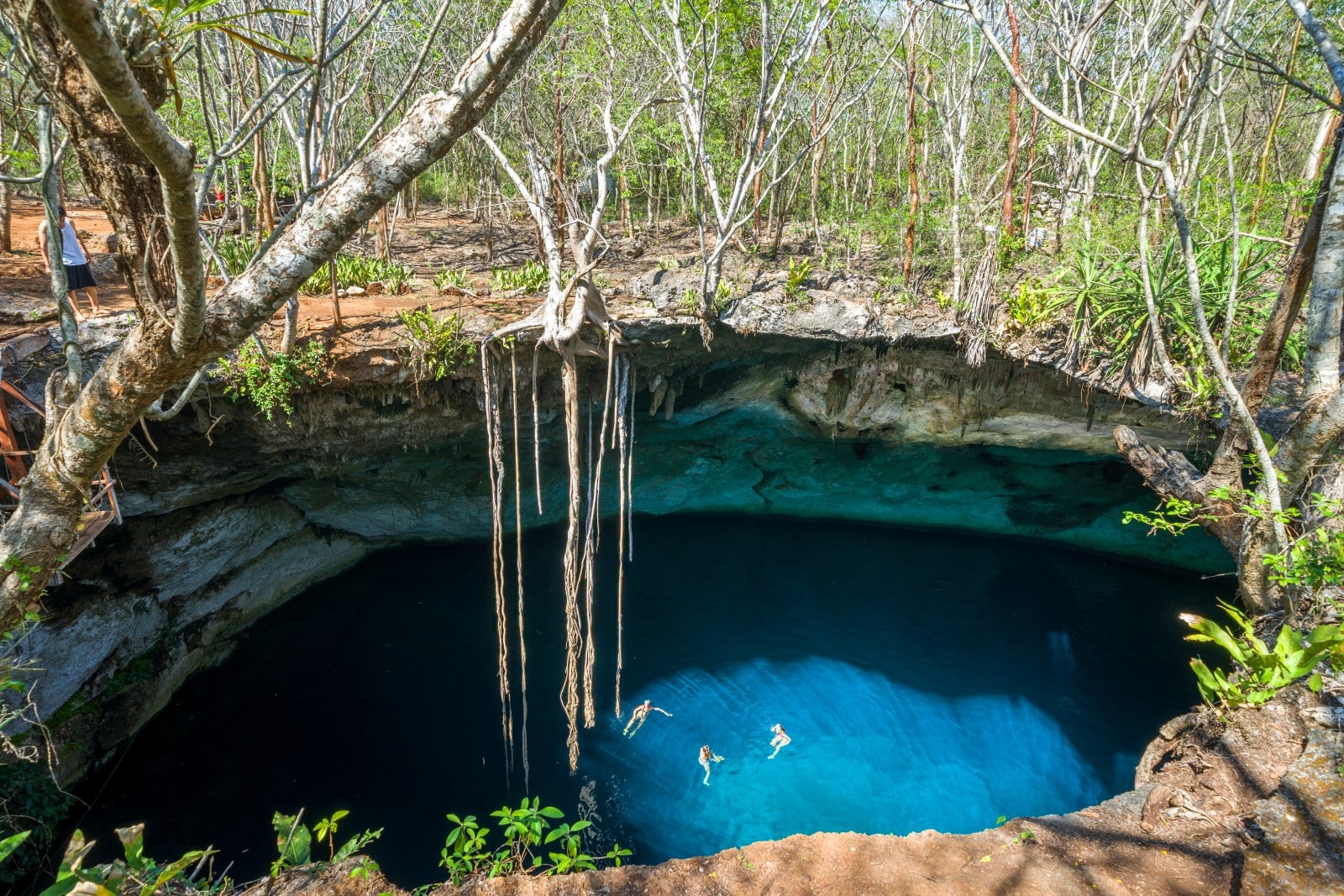
Cenote Noh Mozon is a lesser-known but incredibly beautiful cenote located in the Yucatán Peninsula of Mexico. Unlike the more popular cenotes that often attract large numbers of tourists, Noh Mozon offers a more secluded and tranquil experience, making it a hidden gem for visitors seeking a peaceful natural setting.
Location: Cenote Noh Mozon is situated near the small town of Pixyah, which is in the Municipality of Tecoh, Yucatán. This location places it relatively close to Mérida, the capital city of Yucatán state.
How to Get There:
- From Mérida: The cenote is about a 1-hour drive from Mérida. The most convenient way to reach it is by car, either a rental or a taxi.
- Driving Directions: To get there, you would typically drive south from Mérida towards the town of Tecoh. From Tecoh, you continue to the village of Pixyah, following the signs to Cenote Noh Mozon.
- Public Transportation: Public transportation options may be limited. However, it’s possible to take a bus or colectivo from Mérida to Tecoh and then a taxi from Tecoh to the cenote.
About Cenote Noh Mozon: Cenote Noh Mozon is an open-air cenote, known for its deep, clear waters and the lush vegetation surrounding it. The cenote has the following features:
- Swimming and Relaxation: It’s a great spot for swimming and enjoying the cool, refreshing waters. The natural setting adds to the relaxing atmosphere, making it a perfect place to unwind.
- Natural Beauty: The cenote is surrounded by natural flora, and its relatively remote location means that it’s often less crowded than more accessible cenotes, offering a more intimate experience with nature.
- Amenities: Being less commercialized, the amenities at Cenote Noh Mozon might be basic compared to the more tourist-oriented cenotes. It’s advisable to bring your own supplies, such as food, water, and swimming gear.
Yax Ha Cenote
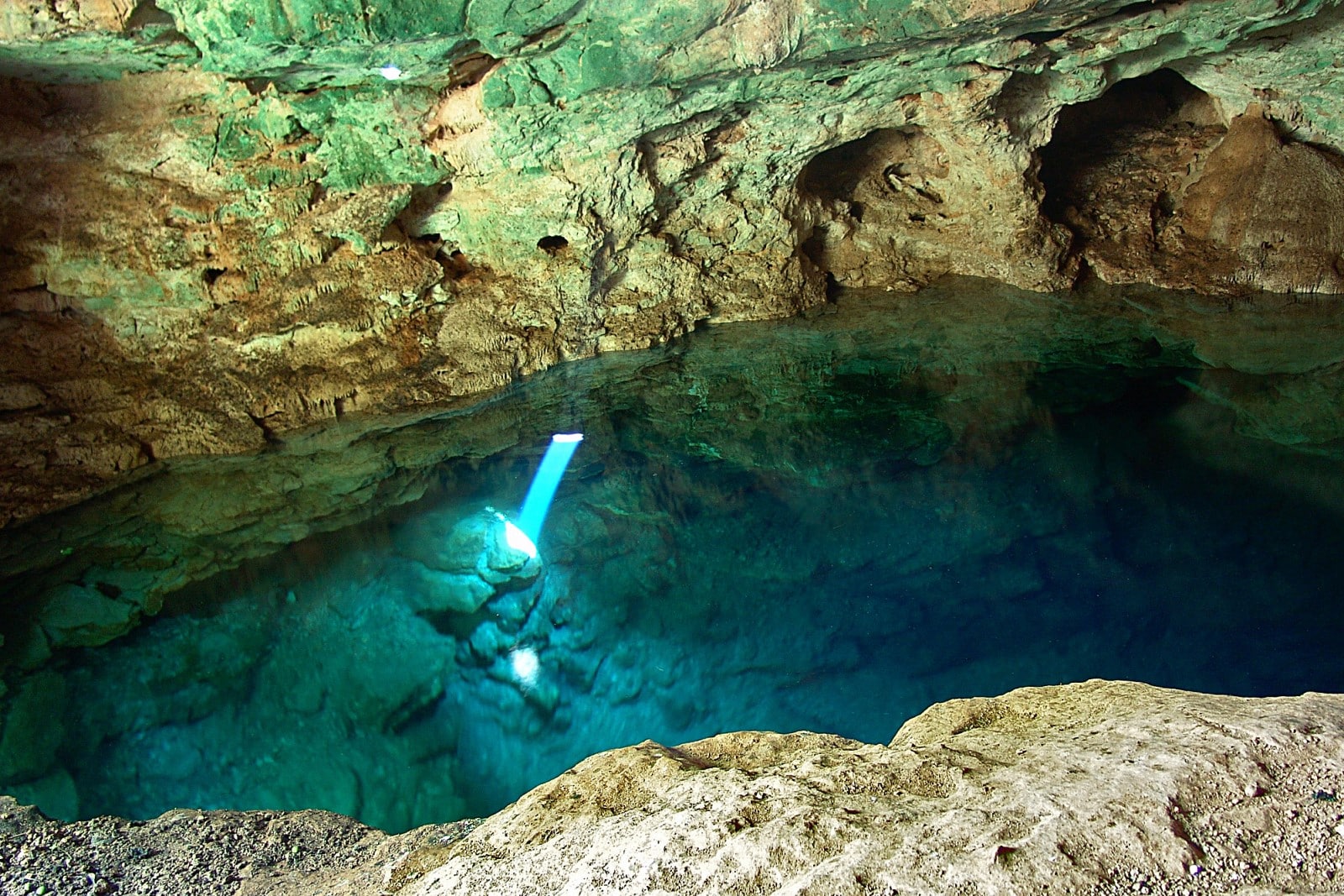
Cenote Yax Ha, less commonly known than some of the larger, more tourist-centric cenotes in the Yucatán Peninsula, is a tranquil and picturesque cenote offering a more secluded and natural experience.
Location: Cenote Yax Ha is located in the Yucatán state of Mexico. The exact location can vary in public sources, as it is not as widely known as other cenotes. It’s often found in rural areas, away from major tourist destinations. This relative seclusion contributes to its tranquil atmosphere.
How to Get There:
- From Nearby Cities: If you’re coming from a city like Mérida or Valladolid, the most practical way to reach Cenote Yax Ha is by car. The journey might involve travel on smaller, rural roads.
- Driving Directions: Precise driving directions can depend on your starting location. It’s advisable to use a reliable GPS or mapping service, especially since signage to less-known cenotes can be minimal.
- Public Transportation: Given its likely off-the-beaten-path location, public transportation options may be limited or non-existent. A combination of buses and taxis might be required, but this could be challenging without local knowledge or language skills.
About Cenote Yax Ha: As a less-visited cenote, Yax Ha offers a peaceful environment, ideal for those looking to escape the crowds and enjoy a more authentic natural setting.
- Swimming and Relaxation: It’s a great spot for swimming, with clear and refreshing waters typical of Yucatán cenotes.
- Natural Surroundings: The cenote is likely to be surrounded by lush vegetation, adding to its secluded and serene ambiance.
- Amenities: Facilities at less-known cenotes like Yax Ha are often basic. It’s a good idea to bring your own necessities, including food, water, and swimming gear.
The Cenote Yax Ha offers a chance to enjoy the peaceful and unspoiled beauty of the region.
Here is a breakdown of Yucatan’s Canote
Less Crowded Cenotes:
- Cenote X’Canche (near Ek Balam) – Offers a tranquil experience with swimming and some adventure activities like rappelling, but not known for scuba or cave diving.
- Cenote Noh Mozon – A secluded spot ideal for swimming in a peaceful setting, but limited in terms of scuba diving or snorkeling facilities.
- Cenote Yax Ha – Likely to be less crowded due to its lesser-known status, great for a serene swimming experience, but not a common destination for scuba or cave diving.
Cenotes Offering Scuba Diving, Snorkeling, and Cave Diving:
- Cenote Dos Ojos – Famous for both snorkeling and scuba diving, including cave diving in its extensive underwater cave system.
- Cenote Chac Mool – Known for its halocline phenomenon, it’s a popular spot for scuba and cave diving.
- Cenote Cristalino – Ideal for snorkeling due to its clear waters, and offers a pleasant scuba diving experience.
- Cenote Ponderosa (Eden) – Suitable for snorkeling and scuba diving, with beautiful underwater formations.
Popular and Potentially Crowded Cenotes:
- Cenote Ik Kil – A well-known cenote often crowded, especially due to its proximity to Chichen Itza; more suitable for swimming and snorkeling than scuba diving.
- Gran Cenote – Popular for snorkeling and scuba diving, but its fame means it can get quite crowded.
- Cenote Azul – A popular spot near Playa del Carmen, great for swimming and snorkeling but can be busy.
Moderately Visited Cenotes:
- Cenote Suytun – Known for its iconic central platform; offers a unique swimming and photography experience, but not known for scuba or cave diving.
- El Jardín del Edén (Ponderosa) – Offers a nice balance between natural beauty and available amenities, good for snorkeling and swimming.
Each of these cenotes has its unique charm and set of activities. The less crowded ones provide a more tranquil experience, while the popular ones offer more developed facilities and sometimes more diverse water activities. Always check the current status and accessibility of these cenotes before planning your visit, as conditions and regulations can change.


